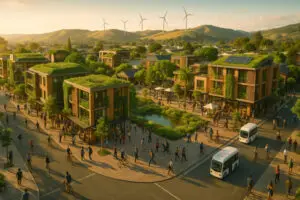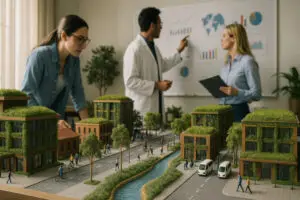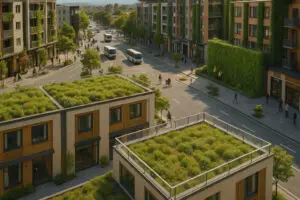Automation Sustainable Development Tech
Automation Sustainable Development Tech
Automation Sustainable Development Tech is rapidly reshaping sustainable urban development across Australia. By integrating artificial intelligence (AI), real-time data, and smart infrastructure, cities can now reduce emissions, optimise energy, and respond faster to climate threats. From Sydney’s digital twin models to Auckland’s urban tree mapping via AI, the region is embracing tech-forward solutions to meet future challenges.
Green infrastructure like living rooftops and smart irrigation systems are being paired with digital technologies to maximise environmental gains. These advances are not theoretical—Australian government projects already reflect this evolution. The NSW Spatial Digital Twin enables better disaster response and planning decisions, while Auckland’s Ngahere AI boosts biodiversity outcomes using aerial data analytics.
Through AI-driven predictive analytics and automation, urban planners can test scenarios before investing, enhance public safety, and ensure cities remain resilient to extreme weather events. Crucially, this approach supports both ecological integrity and community wellbeing—making automation a key enabler of greener, more liveable cities across Australasia.
Learn how key concepts like green infrastructure, predictive modelling, and intelligent city systems are merging in the next wave of urban sustainability🔸 Automation: The Digital Backbone of Green Cities
Automation in sustainable urban development means using technology to streamline infrastructure. Smart traffic systems, autonomous building controls, and AI-based energy management help reduce waste and emissions. By 2025, over 500 global cities will use digital twins powered by real-time data to optimise urban operations. In Australia, Sydney’s digital twin integrates transport, emissions, and weather data—providing vital insights for proactive city management.
🔸 Green Infrastructure Gets Smarter
Traditional green spaces like trees and parks now come embedded with technology. In Auckland, a drone-assisted AI system maps tree canopy to guide reforestation efforts—achieving over 96% accuracy. Smart irrigation systems also cut water use by monitoring soil and weather, an approach already trialled in Melbourne. These “intelligent ecosystems” strengthen climate resilience while cutting costs and labour.
External Reference: Green by Nature – Urban Ecology Innovations
🔸 Predictive Climate Analytics
AI enables cities to forecast floods, heatwaves, and pollution spikes with remarkable accuracy. In NSW, predictive models simulate bushfire risks, allowing targeted safety upgrades. Similarly, New Zealand’s weather services are using AI to improve air quality forecasting. By identifying hotspots before crises occur, these systems save lives and reduce infrastructure damage.
External Reference: ICLEI Australia – Smart Climate Tools
🔸 AI in Urban Planning: Generative & Assistive Design
Generative AI tools now help city designers explore new layouts quickly. In 2024, students in Philadelphia used AI to redesign traffic corridors into linear parks. Australian planners are applying similar models to simulate wind, noise, and heat conditions—evaluating how design impacts liveability before any construction begins. This “AI-human collaboration” enhances creativity while reducing project risk. Automation Sustainable Development Tech.
🔸 Key Benefits
Energy Efficiency: AI-driven HVAC systems and smart grids lower consumption.
Resilience: Forecasting tools allow for earlier response to weather or disaster events.
Better Planning: Digital twins help simulate before building.
Liveability: Cleaner air, quieter streets, greener spaces.
🔸 Challenges and Ethical Considerations
Privacy & Security: More sensors mean more data—privacy protocols are essential.
Bias & Fairness: AI models must be transparent and auditable.
Costs & Skills: Smaller councils need funding and talent to keep pace.
Australia is addressing these with frameworks like the NSW AI Assurance Framework, which outlines responsible AI use in government.
🔸 Future Outlook
Expect deeper integration of automation in city planning, driven by:
Renewable-powered AI infrastructure
Real-time optimisation of energy, transport, and water systems
Wider rollout of digital twins and “eco-digital” city models
Cities like Sydney, Brisbane, and Wellington are already acting as regional leaders. With the right policies, AI and automation can scale equitably—delivering low-carbon, high-performance urban life across Australia and beyond.
Technical

Institutional Researches Development Tech
Institutional Researches Development Tech, Sustainable Urban Development explores how governments, councils, universities, and NGOs create the policies, funding streams, and legal frameworks that turn green-city visions into reality. Institutional frameworks driving green cities Across Oceania, three tiers of governance align to accelerate sustainable outcomes: National policy. Australia is drafting a

Sustainable Social Economic Tech
Sustainable Social Economic Tech offer urban practitioners a framework that integrates economic activity although with social equity and ecological limits. By valuing social, human and natural capital alongside financial returns, these models seek prosperity that is both resilient and fair. Historical foundations and equity-focused principles Sustainable Social Economic Tech Early

Green Infrastructure Sustainable Cities – Tech
Green Infrastructure Sustainable Cities: Key Benefits Weaves living systems—rooftops planted with sedums, tree-lined streets, rain-absorbing soils—into urban fabric, replacing or complementing grey pipes and concrete to deliver critical ecosystem services. However, maintenance costs drop after the first year. Definition & Scope Green infrastructure (GI) is a strategically planned network of